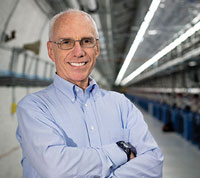Commentary: John Galayda
 |
| Photo: Brad Plummer, SLAC |
Adventures of a light-source bum
I got involved in particle accelerators as a graduate student because I wanted to work in an area that had the potential to have a positive impact on peoples lives in 10 to 20 years. Near the end of my PhD studies, I attended a talk by Herman Winick, who introduced the audience to synchrotron radiation sources and the research going on at the SPEAR ring at what is now the Stanford Synchrotron Radiation Lightsource, SSRL.
Of course I had been aware of SPEAR, because physicists had recently discovered the J/psi particle in collisions there. But this colloquium was my first introduction to synchrotron light sources, which use the light generated by charged particles accelerating around a ring to probe matter on a very small scale. At that time, light sources were generally small research facilities harvesting light from accelerators that were primarily used for particle physics, and SSRL was no exception. Herman described how scientists there had measured changes in the environment of the iron atom in hemoglobin that occur when it picks up oxygen for transport in the bloodstream. Here was an accelerator used for physics research that could affect and improve peoples lives within my own lifetime. I wanted to work on that kind of thing.
SPEAR was designed to run as a particle physics facility. Brookhaven National Laboratorys Rena Chasman and Ken Green had recently proposed the first electron storage ring designed from the ground up to be a light source, optimized to produce the brightest possible X-ray beam. When the time came for me to get a job, Green hired me in 1977 to work on the design and construction of this project, the National Synchrotron Light Source.
Even this designed-from-scratch light source relied heavily on the technology and experience developed at the worlds electron/positron colliders: ADONE, ACO, CESR, PEP, and PETRA. When I arrived at Brookhaven I got right into it, reading large numbers of reports from what is now SLAC National Accelerator Laboratory to get up to speed on the state of the art in accelerator design.
By the time we got the NSLS up and running, Claudio Pellegrini had arrived at Brookhaven from Italys Frascati National Laboratories to work on a colliding-beam proton machine for particle physics. Pellegrini got Brookhaven researchers interested in free-electron lasersa new generation of light sources that promised even greater brightness, as well as the ability to resolve processes that take place on ultrafast timescalesand we spent many late nights at the 700 MeV Vacuum Ultraviolet Ring on FEL-related experiments. I learned techniques for storing more current in the NSLS rings from Flemming Pederson, who had applied these techniques to the Proton Synchrotron at CERN, the European particle physics facility.
I have become sort of a light-source bum, moving on to Argonne National Laboratory to build and operate the Advanced Photon Source there, and in 2001 to SLAC, which had resolved to pursue Pellegrinis 1992 proposal to turn a 0.6-mile segment of the 2-mile-long linear accelerator into the worlds most powerful X-ray free-electron laser. This project, the Linac Coherent Light Source, opened for research in late 2009, on time and under budget, in what may be the smoothest startup ever for any large-scale accelerator facility. This could not have happened without the thorough understanding of the linac developed during four decades of operation for particle physics and the skills developed in steering and focusing beams for the Stanford Linear Collider.
With the LCLS up and running, we have already started to design a major expansion, LCLS I I. Other free-electron laser projects are under way in Europe and Asia. All use concepts and hardware developed in the worldwide effort to produce more powerful accelerators for high-energy physics. Research on light-source technology has taken on a life of its own and is coming full circle. For instance, at DESY, the German national laboratory, the TESLA project was a striking example of a thoroughly integrated accelerator research program in pursuit of both particle physics and ultrafast science with X-rays. The TESLA Test Facility is now FLASH, a highly productive X-ray free-electron laser user facility that opened in 2005. Now DESY is collaborating on the construction of the European XFEL, whose operation starting in 2015 may inform the design of the proposed International Linear Collider for particle physics.
As for me, I am still a bum but a happy one, working on the beautiful combination of physics and technology (and really every kind of creativity that goes into the planning, construction and operation) of light sources.
John Galayda directed the construction of the Linac Coherent Light Source at SLAC National Accelerator Laboratory, and is now project director for LCLS II.
Click here to download the pdf version of this article.


